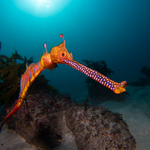With the ongoing volcanic eruption at La Palma, this little-known island continues to hit the headlines worldwide. Amidst the devastation, there are signs of new beginnings, with dive sites being created by lava flows as we speak. Offering crystal-clear waters and evolving lava landscapes busy with life, La Palma diving is a must. Read on to find out more and delve into the fascinating world of lava diving.
La Palma diving – welcome to the lava lands.
Where is La Palma?
La Palma is one of the smaller Canary Islands, which lie off northwestern Africa. These popular islands are known for their volcanic landscapes, distinct black sands and fascinating underwater landscapes, which attract people to diving in the Canary Islands every year.
Unlike the better-known Canary Islands, La Palma is a hidden gem many people are unaware of. It is swathed in forests and dotted with volcanoes, and it hosts the Caldera de Taburiente National Park.
This volcanic national park has fantastic hiking trails that wind among Canary Island pine forests and an enormous volcanic crater surrounded by rugged peaks.
La Palma also boasts the Roque de Los Muchachos Observatory, perched on the edge of the Caldera de Taburiente National Park. At 2396 meters above sea level, it is one of the best places for stargazing in the Northern Hemisphere.
Yet despite being a paradise for hikers and astronomists alike, with numerous underwater wonders as well, La Palma diving has always been quite unknown.
READ MORE: CANARY ISLANDS DECLARED A HOPE SPOT.
Lava still flowing 80 days after volcanic eruption.
La Palma hit news headlines around the world on 19th September 2021. On this day, a new volcano erupted in the chain of volcanos that form the Cumbre Vieja volcanic ridge.
As of 9th December 2021, 80 days after the eruption, this volcano is still spitting lava and ashes.
It has taken over 2000 buildings, the small town of Todoque, homes, livelihoods, and memories on its path towards the ocean.
The ash has interrupted air traffic and the entire tourism industry has been seriously affected. After nearly two years of dealing with Covid, this difficult situation has been made worse for all those who depend on tourism.
But the volcano does not only destroy. It also creates new life.
DISCOVER FEATURED PLACES TO GO DIVING IN THE CANARY ISLANDS.
Where volcanoes erupt, new life begins.
The lava flow has created a new piece of land, covered a sandy area and reached interesting depths.
New small beaches, a beautiful new landscape, and promising future dive sites are developing as we speak.
It will be incredibly interesting to observe how marine life comes back to this place.
Not long after the eruption of an underwater volcano on the neighboring island of El Hierro in 2011, divers observed how life around the volcano was growing to amounts of diversity never seen before.
La Palma is a volcanic island, so there is a good estimation already about how this newest La Palma diving landscape will look.
What makes La Palma diving so special?
All of the underwater landscapes and the marine environment we can see at La Palma originate from volcanos, including the Teneguia eruption on La Palma in 1971.
There is this beautiful dive site Las Cabras, with a small bay as an entry point surrounded by black sand and lava that feels like being on the moon.
It is like a black desert on land, but underwater, the colors just explode. Lots of fish, yellow and red sponges, green and pink algae, and black corals.
Together they add the perfect amount of color and movement to the impressive lava flows, the beautiful lava pillows and the arches and swim-throughs created by the Teneguia eruption.
READ MORE: 8 TOP WAYS TO MAKE SHORE DIVING EASY.
La Bombilla is a stunning collection of arches, created in 1949 by the eruption of the San Juan volcano. Although it is not accessible at the moment, the construction of all of these arches would not have happened without a volcano.
Further East, at El Fraile, some of the very old lava flows look like dragons, elephants and octopi.
And there is Malpique, made of basalt columns, sand and old rock formations. An old underwater landscape of lava, surrounded by young lava on land, which barely reached the shore.
In Malpique, there is just everything: some fresh lava bubbles, basalt columns, arches and a tower.
It serves as the favorite living room for lots of small swarms of fish, huge stingrays, sleeping butterfly rays who dance in the night, octopi, moray eels, and so much more.
Yes, there is an active volcano on La Palma and it makes travelling a bit more challenging. But visiting the island and experiencing the rewards of La Palma diving make it well worth the effort.
Underwater, the ashes transform into the beautiful black sands that make our waters so incredibly clear.
GO LAVA DIVING – PLAN YOUR LA PALMA DIVE ADVENTURE HERE.
The post La Palma Volcano: New Dive Sites Form As Lava Flows On appeared first on Dive SSI.
Read MoreDiving, Travel, canary islands, dive travel, La Palma, lava divingDive SSI

